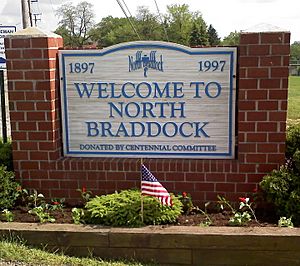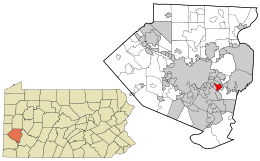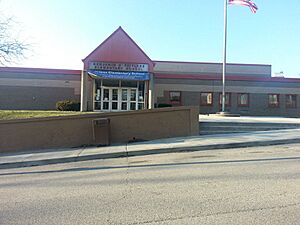North Braddock, Pennsylvania facts for kids
Quick facts for kids
North Braddock, Pennsylvania
|
|
|---|---|
|
Borough
|
|

Borough Welcome Sign
|
|
| Etymology: Edward Braddock | |

Location in Allegheny County and the state of Pennsylvania.
|
|
| Country | United States |
| State | Pennsylvania |
| County | Allegheny |
| Founded | 1897 |
| Area | |
| • Total | 1.55 sq mi (4.02 km2) |
| • Land | 1.49 sq mi (3.87 km2) |
| • Water | 0.06 sq mi (0.16 km2) |
| Population
(2020)
|
|
| • Total | 4,320 |
| • Density | 2,895.44/sq mi (1,117.65/km2) |
| Time zone | EST |
| • Summer (DST) | EDT |
| ZIP code |
15104
|
| Area code(s) | 412 |
| FIPS code | 42-54816 |
| School District | Woodland Hills |
North Braddock is a small town, called a borough, in Allegheny County, Pennsylvania. It sits right next to the Monongahela River. In 2020, about 4,320 people lived there.
North Braddock is a suburb located about 11 miles (18 km) east of Pittsburgh. It was officially formed in 1897 from a part of Braddock Township. This town is very proud to be known as the "Birthplace of Steel." This is because Andrew Carnegie's famous Edgar Thomson Steel Works opened here in 1875.
Contents
History
Early Days
In 1742, a Scottish trader named John Fraser bought land where the Edgar Thomson Steel Works is now. He bought it from Queen Aliquippa and the Lenape people. Fraser and his family settled there.
In 1753, Christopher Gist and George Washington visited Fraser. They were delivering messages from the Governor of Virginia to French commanders. The governor wanted the French to leave western Pennsylvania. Fraser worried about a fight and moved back to Philadelphia in 1754.
Braddock's Field Battle
In 1755, General Edward Braddock and British soldiers came from Virginia. Fraser guided them, and General Washington was an aide. Their goal was to remove the French from Fort Duquesne.
On July 9, 1755, the British troops reached Fraser's cabin. French soldiers attacked them there. General Braddock was hurt during the battle. He died on July 13, 1755, in nearby Uniontown. The place where Braddock was shot became known as Braddock's Field. Today, you can find historical markers on Jones Avenue that show where this important event happened. The Braddock's Battlefield History Center also tells the story of this battle.
The Whiskey Rebellion
In the late 1700s, farming was very common in the North Braddock area. The nearby Monongahela River was used for trading goods. Whiskey became a very popular product to trade. Much of it was sent to the New Orleans area.
In 1794, a new tax was put on whiskey. This made many people angry. Over 8,000 settlers from western Pennsylvania gathered in the North Braddock area to protest. This event was part of the Whiskey Rebellion. The angry settlers did not want to leave. President Washington himself led an army to stop the rebellion.
Wallace Mansion
Captain Edmondstone, a British commander, gave 328 acres (1.3 km²) of land to Peter Rowletter. This was a gift from King George III of Great Britain. After the French and Indian War, Rowletter sold the land to George Wallace, a judge from Pittsburgh.
Judge Wallace bought about 328 acres (1.3 km²) of land, including part of Braddock's Field, on March 4, 1791. He built a large house there to use as his summer home. Later, a famous visitor, the Marquis de La Fayette, stopped by Judge Wallace's mansion on May 28, 1825. After Judge Wallace passed away, his nephew inherited the home. However, the nephew lost the property. In the 1830s, the Wallace mansion was used as a boarding school for girls called the Edgeworth Ladies Seminary.
Coal and Steel Industry
In 1835, the first coal mine opened near Sixth Street. During the 1800s, railroads were growing all over the country. This meant there was a huge need for steel.
Andrew Carnegie decided to build his first steel mill in 1872. He named it after John Edgar Thomson, who was the president of the Pennsylvania Railroad. By 1873, the demand for steel for railroads had dropped. So, the building of the mill stopped for a while. But then, Carnegie got a $2 million loan. He finished the steel mill, and it started making steel under the leadership of William R. Jones. The mill continued to grow. In 1880, the first blast furnace was used at the Edgar Thomson Steel Works.
Becoming a Borough
In 1897, the town of East Pittsburgh tried to take over the land around the steel mill in North Braddock. This area was known as Bessemer and was part of Braddock Township.
People living in Shady Park village and Wolftown wanted to stop East Pittsburgh. They held meetings to prevent the land near the mill from being taken. William Yost, North Braddock's lawyer, asked the court to let Shady Park and Wolftown join together as one town. They also wanted to include Braddock's Field.
During the meetings, 317 out of 510 property owners signed an agreement. This helped Judge Kennedy make his decision to form a new town. On Monday, April 26, 1897, North Braddock officially became a borough. Judge Kennedy of the Quarter Sessions Court of Allegheny County made the ruling. The first election for officials was held on May 18, 1897.
North Braddock celebrated its 100th birthday with a special festival in June 1997.
Geography
North Braddock is located at 40°24′18″N 79°51′23″W / 40.40500°N 79.85639°W. It sits on a sloped area of land. Below it is Braddock, which is right on the Monongahela River. Above it is East Pittsburgh, which is on higher ground.
The United States Census Bureau says the borough covers about 1.6 square miles (4.1 km²). Most of this area, about 1.5 square miles (3.9 km²), is land. The rest, about 0.1 square miles (0.26 km²), is water.
Neighboring Areas
North Braddock shares its borders with five other places:
- Braddock Hills to the north
- Chalfant to the northeast
- Wilkins Township to the east
- East Pittsburgh to the east and southeast
- Braddock to the southwest and west
Across the Monongahela River to the south, North Braddock is next to Kennywood Park in West Mifflin.
Population Facts
| Historical population | |||
|---|---|---|---|
| Census | Pop. | %± | |
| 1900 | 6,535 | — | |
| 1910 | 11,824 | 80.9% | |
| 1920 | 14,928 | 26.3% | |
| 1930 | 16,782 | 12.4% | |
| 1940 | 15,679 | −6.6% | |
| 1950 | 14,724 | −6.1% | |
| 1960 | 13,204 | −10.3% | |
| 1970 | 10,838 | −17.9% | |
| 1980 | 8,711 | −19.6% | |
| 1990 | 7,036 | −19.2% | |
| 2000 | 6,410 | −8.9% | |
| 2010 | 4,857 | −24.2% | |
| 2020 | 4,320 | −11.1% | |
| Sources: | |||
In the year 2000, there were 6,410 people living in North Braddock. These people lived in 2,631 households, and 1,681 of those were families. The population density was about 4,155 people per square mile (1,604 people/km²).
About 61.70% of the people were White, and 35.30% were African American. Other groups made up smaller parts of the population. About 1.25% of the people were Hispanic or Latino.
About 28.5% of households had children under 18 living with them. About 35.0% were married couples. About 23.0% were households led by a woman without a husband present.
The average age of people in the borough was 39 years old. About 27.0% of the population was under 18 years old. About 18.4% were 65 years or older.
In 2000, the average income for a household in North Braddock was $24,335. For families, the average income was $30,473. About 22.7% of all people in North Braddock lived below the poverty line. This included 40.4% of those under 18 years old.
Education
North Braddock used to have its own school district. But in the 1970s, it joined with other areas to form the General Braddock Area School District.
Later, in 1981, the General Braddock Area School District merged again. This time, it joined with 12 other nearby communities to create the Woodland Hills School District. The main office for the Woodland Hills School District is located in the old Fairless Elementary School building in North Braddock.
Notable People
Many interesting people have come from North Braddock:
- Steve Breaston: An NFL wide receiver who also played for the University of Michigan and Woodland Hills High School.
- Summer Lee: A U.S. representative for Pennsylvania's 12th congressional district.
- Wes Lyons: An NFL tight end/wide receiver. He played for West Virginia University and Woodland Hills High School. He is also an author.
- Coley McDonough: An NFL quarterback for the Pittsburgh Steelers and Chicago Cardinals. He played for North Carolina State University and North Braddock Scott High School. He later became a Pittsburgh police officer and died while on duty.
- Elmer Merkovsky: An NFL player for the Pittsburgh Steelers. He played for the University of Pittsburgh and North Braddock Scott High School.
- Lousaka Polite: An NFL fullback. He was a star player at the University of Pittsburgh and Woodland Hills High School.
- Fran Rogel: An NFL fullback for the Pittsburgh Steelers. He played for Penn State University and North Braddock Scott High School.
- Benjamin L. Rosenbloom: A graduate of North Braddock High School and West Virginia University. He became a lawyer and a U.S. Representative for West Virginia.
- Jim Zockoll: A person known for starting many successful businesses through franchising.
Images for kids
See also
 In Spanish: North Braddock para niños
In Spanish: North Braddock para niños



